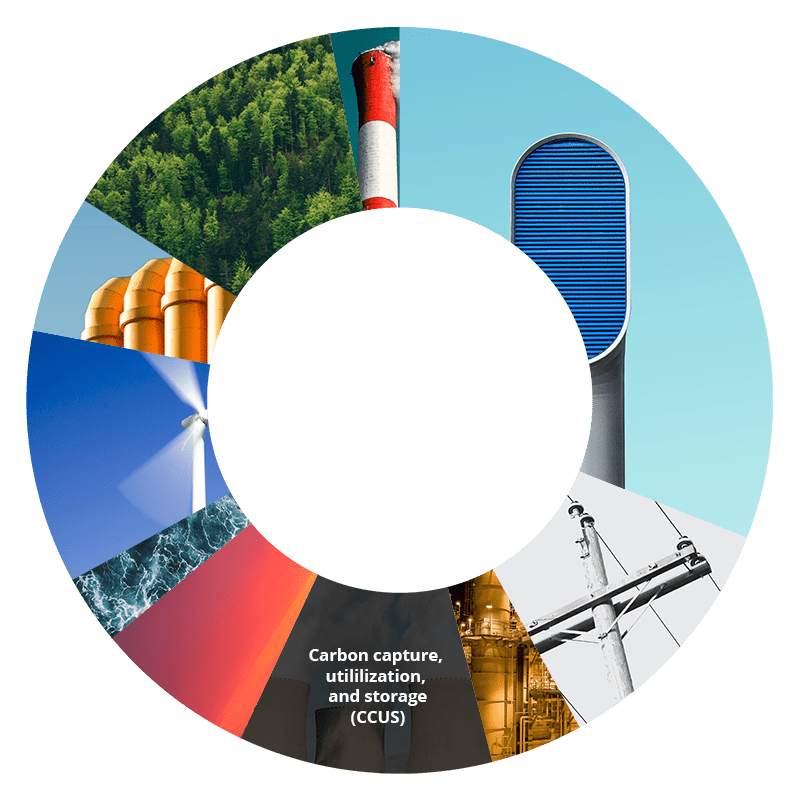How Canada
can decarbonize by 2050
We’ve made an international commitment to help roll back climate change. Now we need to choose the pathways to reach our target.


Canada has joined a growing list of countries, including Japan, France, and the United Kingdom, in pledging to reach net-zero carbon emissions by 2050. This means balancing the planet-warming greenhouse gasses (GHGs) we produce from burning fossil fuels with those we remove by switching to zero carbon alternatives. Reaching net-zero by 2050 is likely our last chance to limit global temperature rise to within 1.5oC by the end of the century. If we miss this window, the global impact could be devastating—not just for those already experiencing the adverse effects of climate change but also for future generations.
Deloitte Canada partnered with Navius Research to look at two possible courses of action. Using their comprehensive gTech model, we charted a business-as-usual path and a potential pathway for reaching net-zero emissions by 2050. But how can Canada slash its use of fossil fuels over the next three decades?
Discover how Canada can
navigate to net-zero emissions
How Canada can navigate to net-zero emissions












Renewable energy
Just 7 percent of our energy is supplied by non-hydro renewables. Diversifying supply chains for materials vital to renewable infrastructure could increase the usage of renewables. Biogenic, low-carbon fuel innovations could be used in transport sectors where electricity isn’t viable. Read more
Direct air capture
An area in which Canada is an emerging world leader, clean DAC is contingent on the scale and progress of advancements in this technology. Since DAC consumes energy, its economic and environmental viability depends its proximity to renewable energy sources. Read more
Nature-based solutions
Decisive action in the short term can restore lost and degraded habitats, as well as protect the longevity of ecological functions and ecosystem services. With long-term funding and indigenous knowledge in sustainable land management, protected areas can be properly managed. Read more
Energy efficiency
Canada must invest more in technologies that improve energy efficiencies for transportation, buildings, industrial, and agricultural and forestry operations. Policies to incentivize both eco-friendly retrofits can be expanded to accelerate the adoption of technology that improves energy efficiencies in buildings. Read more
Electrification
Turning electricity into a major source of power will require more infrastructure support and investment, like expanding and modernizing electricity grids to make widespread electric vehicle use affordable. Increased investments in electric buses and rail could encourage cleaner-energy transit systems. Read more
Fuel switching
Natural gas has lower carbon emissions for power generation and transportation. In keeping with Canada’s commitment to reform fossil-fuel subsidies, pricing policies should be transparent, monitored, and enforced, and should reflect the true economic cost of the energy supplied. Read more
Methane management
New regulations that limit methane emissions from fugitive sources—like the drilling, extraction, and transportation process—will be applied in the near term to the oil and gas sector. Read more
Carbon capture, utilization, and storage (CCUS)
With five large-scale commercial projects now in operation, Canada has the second largest CCUS capacity in the world. Most CCUS technologies, however, are still in the early stages of development and need refinement and cost management. Read more
Hydrogen
Clean hydrogen application in the industrial sector, transportation, and buildings could boost resilience in Canada’s energy sector. New technologies can be scaled to create market demand for low-carbon hydrogen and decarbonizing sectors that cannot yet be fully electrified. Read more
Small modular reactors (SMRs)
An area in which Canada is an emerging world leader, clean DAC is contingent on the scale and progress of advancements in this technology. Since DAC consumes energy, its economic and environmental viability depends its proximity to renewable energy sources. Read more
The various elements in the chart above are all viable resources to drive decarbonization in Canada. Understanding the sequence of these variables, and their interplay with emissions, can help us model a net-zero future for Canada.
It will be a significant challenge, given that Canada is among the world’s top per-capita emitters of GHGs—we emit more than double the G20 average. While the country’s emissions account for just 2 percent of global GHGs, this is no excuse for inaction. In fact, this positions us to stake out a leadership position on an international front.
How can we reduce our dependency on them over the next 30 years? Fortunately, several proven and emerging technologies that could underpin the decarbonization effort are already available in Canada. This article will explore these options, and how understanding and implementing can help nudge us toward our commitment over the next thirty years.


Proven
solutions
The next decade must focus on a rapid transition to carbon-free energy systems. This would mean investing in solutions that are commercially viable today, while piloting emerging technologies that have the potential to unlock significant carbon reduction in the decades to follow.






Emerging
technologies
A long-term decarbonization strategy would rely on emerging technologies—most of which are currently in the demonstration state, and not yet commercially viable. Their deployment would rely on policy and investment decisions that are taken in the next five to 10 years.




A decarbonized and
prosperous Canada
In the journey to zero carbon emissions globally, a few nations need to lead for many to follow. Canada should be at the forefront. There’s no question it will demand change from our governments and businesses, from every family and individual. We have what it takes: Strong national alignment, with many businesses on-board to reduce emissions, the financial sector ready to act on climate risk reduction and low-carbon growth, policymakers considering the best strategies, and industrious entrepreneurs
Canadian organizations must continue to build new solutions and powerful technologies in clean energy to bring down costs, commercialize promising ideas, and spur investment. Indigenous knowledge and stewardship also holds significant potential to amplify the protection and growth of rich natural landscapes. We can join forces through a collective will for planetary health, and make decarbonization a national, non-partisan project.
A net-zero Canada is a net benefit for all. Let’s start now.
Contact
Recommendations
Why Canada is well positioned to deliver net-zero carbon emissions
With temperatures in Canada rising at twice the rate...
Canada's next big opportunity






